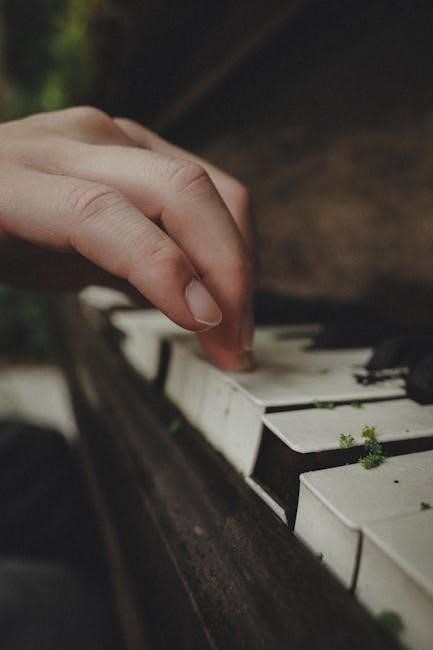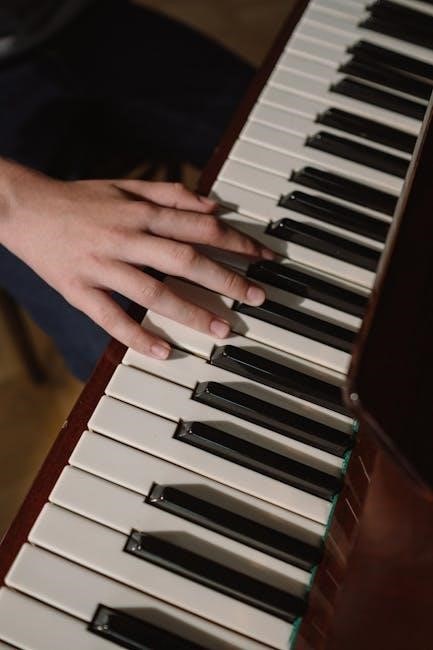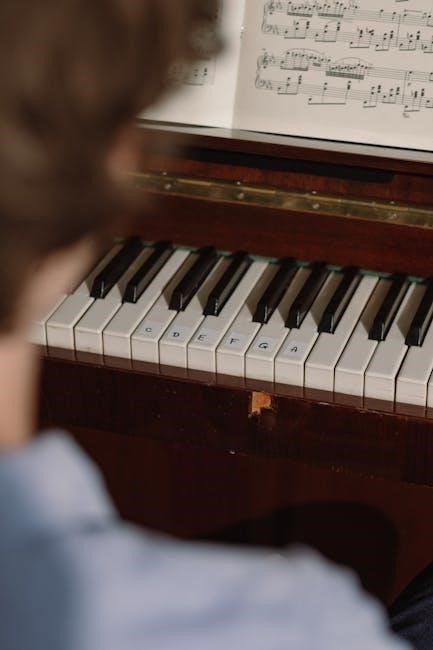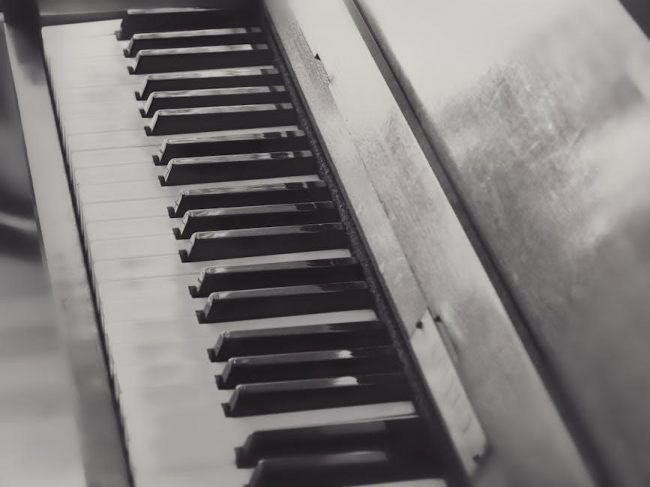Slash chords on piano involve a triad played over a bass note, enabling smooth transitions and enriching harmonies. They are vital in jazz, pop, and worship music, adding depth and complexity.
What Are Slash Chords?
A slash chord is a musical notation where a chord is played over a specific bass note, indicated by a slash. For example, C/Bb means a C major triad played over a Bb bass note. This creates a rich, layered sound. Slash chords are often used to add complexity and depth to music, allowing for smoother transitions between chords. They are particularly common in jazz, pop, and worship music. Unlike traditional chords, slash chords separate the harmony and bass, providing flexibility for pianists to explore new harmonic possibilities while maintaining a steady foundation.
Importance of Slash Chords in Piano Music
Slash chords are essential in piano music for enhancing musicality and expression. They allow pianists to create seamless transitions between chords, preventing abrupt changes in harmony. By specifying a bass note, slash chords add depth and complexity to compositions, making them particularly valuable in jazz and contemporary styles. They also offer flexibility, enabling pianists to experiment with different harmonic structures while maintaining a steady foundation. This versatility makes slash chords a powerful tool for adding emotion and sophistication to musical performances, elevating both simple melodies and intricate arrangements to new heights.

Understanding Slash Chord Notation
Slash chords are notated with a slash, such as C/Bb, indicating the chord and bass note. They are also called compound or inverted chords.
Basic Structure of Slash Chords (e.g., C/Bb, F/A)
A slash chord consists of a chord symbol with a slash and a bass note, such as C/Bb or F/A. The portion before the slash indicates the chord, while the part after specifies the bass note. This structure allows for varied harmonic interpretations, as the same chord can be played over different bass notes, creating unique textures. For instance, C/Bb means a C major triad with a Bb in the bass, while F/A involves an F chord with an A in the bass. This flexibility enhances musicality and provides smooth transitions in compositions.
How to Interpret Slash Chords in Sheet Music
When encountering slash chords in sheet music, the left side of the slash indicates the chord to play, while the right side specifies the bass note. For example, in C/Bb, play a C major triad with a Bb in the bass. This notation guides the pianist to create a specific harmonic and rhythmic effect. The bass note often comes from a scale or chord tone related to the key, ensuring a cohesive sound. Proper interpretation requires understanding the chord structure and its role in the musical context, enhancing the overall performance’s depth and expression.

Benefits of Using Slash Chords in Piano Playing
Slash chords enhance musicality by adding depth and complexity. They allow for smoother transitions between harmonies, creating a richer, more dynamic sound in piano performances.
Creating Smooth Transitions Between Chords
Slash chords are invaluable for creating seamless transitions between chords. By altering the bass note while maintaining the same chord shape, they bridge harmonic gaps, ensuring a smooth flow.
For example, moving from C major to G7 can feel abrupt, but using C/G or G7/C smooths the progression. This technique is widely used in jazz and pop music to enhance continuity.
Enhancing Musicality and Expression
Slash chords add depth and emotional richness to music, allowing pianists to explore nuanced harmonies. By changing the bass note, musicians can alter the feel of a chord, creating intricate layers of sound that elevate a piece beyond basic triads.
This technique is particularly effective in jazz and contemporary music, where expression and complexity are valued. Slash chords enable dynamic shifts in tone, making melodies more engaging and emotionally resonant. They also provide flexibility for creative interpretation, allowing pianists to personalize their performances.
How to Play Slash Chords on the Piano
Playing slash chords involves using the left hand for the bass note and the right hand for the chord, creating a harmonically rich sound.
Left-Hand and Right-Hand Techniques
Mastering slash chords requires coordinating both hands. The left hand plays the bass note, while the right hand plays the chord above it. This technique enhances balance and harmony in music. Regular practice strengthens finger independence and dexterity. Starting with simpler chords like C/Bb and gradually moving to more complex ones ensures a smooth learning curve. Proper hand positioning and finger placement are crucial for clear sound production. Over time, this method becomes second nature, allowing for expressive and dynamic performances.
Practical Exercises for Mastering Slash Chords
Start with warm-up exercises like scales and arpeggios to build finger dexterity. Practice simple slash chords (e.g., C/Bb, G/B) in slow tempos, focusing on clarity. Gradually incorporate these into familiar songs, such as hymns or pop tunes. Experiment with transitions between chords to develop smoothness. Record yourself to track progress and identify areas for improvement. For advanced practice, try seventh and extended slash chords (e.g., G7/F, Am7/D) to expand your harmonic palette. Consistent practice ensures mastery and enhances your ability to play complex piano pieces with confidence.

Common Slash Chords and Their Applications
Slash chords like G/B, C/A, and Am7/D are widely used in jazz and pop music to create rich, layered harmonies and seamless transitions between chord progressions.
Major and Minor Slash Chords (e.g., G/B, C/A)
Major and minor slash chords combine a triad with a bass note, creating rich, layered harmonies. For example, G/B features a G major triad over a B bass, while C/A uses a C major triad over an A bass. Minor slash chords, like Am7/D, blend a minor triad with a bass note, adding emotional depth. These chords are widely used in jazz, pop, and worship music to enhance transitions and harmonic interest. They offer flexibility, allowing pianists to explore complex sounds while maintaining musicality and expression in their playing.
Seventh and Extended Slash Chords (e.g., G7/F, Am7/D)
Seventh and extended slash chords add color and complexity to music. For instance, G7/F combines a G dominant 7th triad with an F bass, while Am7/D blends an A minor 7th triad over a D bass. Extended chords like Cmaj9/G or D11/E expand further, incorporating additional tones. These chords are especially popular in jazz and contemporary music, offering rich, nuanced harmonies. They allow pianists to create intricate, layered sounds while maintaining smooth transitions. Seventh and extended slash chords are versatile, enhancing both accompaniment and solos with depth and musicality.

Resources for Learning Slash Chords
Explore comprehensive guides, tutorials, and lessons to master slash chords. Utilize PDF resources, video tutorials, and interactive tools to deepen your understanding and improve your technique effectively.
Recommended PDF Guides and Tutorials
Discover a wealth of detailed PDF guides and tutorials that offer step-by-step lessons on mastering slash chords. These resources provide in-depth explanations, practical exercises, and real-world examples to help pianists of all levels. From understanding basic triads to advanced harmonic applications, these guides cover it all. Many PDFs include chord charts, progressions, and tips for incorporating slash chords into various musical genres. Ideal for both beginners and advanced players, these materials are designed to enhance your skills and inspire creativity. They often include video accompaniments for a comprehensive learning experience.
Online Lessons and Video Tutorials
Enhance your piano skills with online lessons and video tutorials dedicated to slash chords. Platforms like YouTube, Piano Nanny, and Jazz Piano Lessons offer structured courses. Channels such as HDpiano and Piano Lessons On The Web provide clear demonstrations. These resources often include step-by-step guides, practical exercises, and real-time feedback. Many tutorials focus on applying slash chords in popular songs, worship music, and jazz standards. Whether you’re a beginner or an advanced player, these videos offer a dynamic way to learn and master slash chords in a visually engaging format. They are accessible anytime, making learning flexible and convenient.
Slash chords are a powerful tool for pianists, enhancing musicality and creating smooth transitions. They add depth to chord progressions, making music more engaging. By mastering slash chords, pianists can explore new harmonic possibilities across genres like jazz, pop, and worship. Regular practice, combined with the use of PDF guides and online tutorials, can help refine these skills. Embrace the versatility of slash chords to elevate your playing and bring richness to your performances. Keep exploring and experimenting to unlock their full potential in your musical journey.
